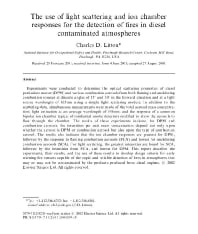Mining Publication: The Use of Light Scattering and Ion Chamber Responses for the Detection of Fires in Diesel Contaminated Atmospheres
Original creation date: June 2002
Authors: CD Litton
Experiments were conducted to determine the optical scattering properties of diesel particulate matter (DPM) and various combustion aerosols from both flaming and smoldering combustion sources at discrete angles of 15 degrees and 30 degrees in the forward direction and at a light source wavelength of 635 nm using a simple light scattering module. In addition to the scattering data, simultaneous measurements were made of the total aerosol mass concentration; light extinction at an average wavelength of 546 nm; and the response of a common bipolar ion chamber typical of residential smoke detectors modified to allow the aerosols to flow through the chamber. The results of these experiments indicate, for DPM and combustion aerosols, the intensities per unit mass concentration depend not only upon whether the aerosol is DPM or combustion aerosol but also upon the type of combustion aerosol. The results also indicate that the ion chamber responses are greatest for DPM, followed by the response to flaming combustion aerosols (FCA) and lowest for smoldering combustion aerosols (SCA). For light scattering, the greatest intensities are found for SCA, followed by the intensities from FCA, and lowest for DPM. This report describes the experiments, their results, and the use of these results to develop design criteria for early warning fire sensors capable of the rapid and reliable detection of fires in atmospheres that may or may not be contaminated by the products produced from diesel engines.

- Advanced Strategies for Controlling Exposures to Diesel Aerosols
- Control Technologies and Strategies for Reducing Exposure of Underground Miners to Diesel Emissions
- Early Fire Detection for Underground Diesel Fuel Storage Areas
- Effects of a diesel particulate filter regeneration process on aerosols in an underground mine
- Effects of Diesel Exhaust Aftertreatment Devices on Concentrations and Size Distribution of Aerosols in Underground Mine Air
- Fire Detection
- Overview of Mine Fire Detection
- Role of Lubrication Oil in Particulate Emissions from a Hydrogen-Powered Internal Combustion Engine
- Technology News 514 - The Air Quantity Estimator (AQE): A New Computer Software Tool for Large-opening Mine Ventilation Planning
- Toward developing a new occupational exposure metric approach for characterization of diesel aerosols